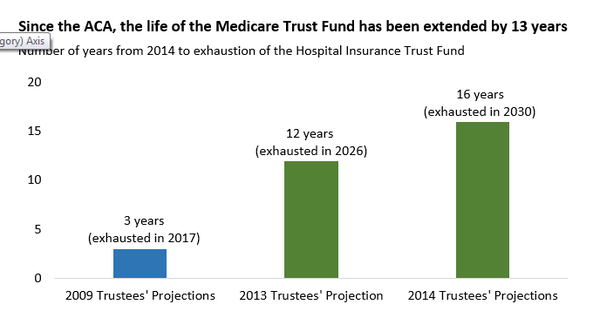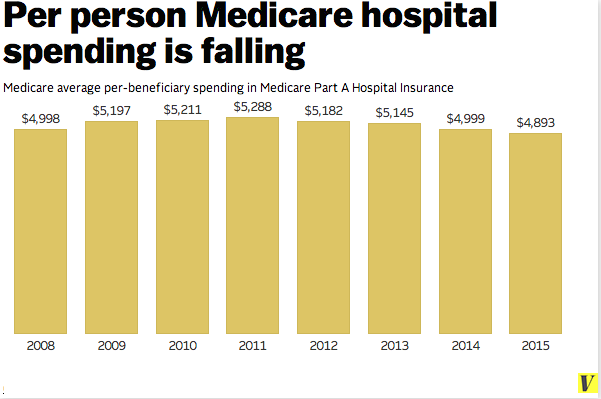Who knew we could expand coverage while saving trillions on health care? Oh. Only every industrialized country in the world.
We know that about 10 million Americans have gained health insurance in the last seven months as America has enjoyed its best year of job creation since 1999.
But the best news about Obamacare — besides the more than 12,000 American lives a year it will save if the law’s effectiveness resembles Romneycare’s — is the life it has added to Medicare.
The Boards of Trustees for Medicare reported on Monday that the life of Medicare Part A has been extended again. This time by four years. Since the Affordable Care Act became law in 2010, the Trustees have added 13 years to the program’s life, leaving it fully funded until 2030.

There are two huge caveats to these predictions.
Medicare can only go “broke” if the U.S. government lets it. Predictions of Medicare running out of money are as old as the program and are generally trumped up to provoke cuts.
Also, predicting medical spending is nearly impossible. No one could have predicted costs would have slowed down as much as the have in recent years, even as the economy improved. And even experts fear we could go back to the kind of growth in costs that had the Trustees predicting the next president of the United States would face a Medicare crisis in her first year.
The slowdown in costs is mysterious in many ways — but nearly all experts give at least some credit to reforms in the law, especially those focused on hospital readmissions.
But for now the news is very good — even amazing.
“By 2015, the Medicare Trustees’ Report projects that the program will spend less per person on hospital care than it did in 2008,” Vox‘s Sarah Kliff wrote. “This doesn’t happen much in health care: not just slower growth, but the actual dollar amount spent on a given type of care dropping.”

If the projected savings continue at this rate, our long-term deficit problem may be solved.
Time‘s Mike Grunwald explains:
In 2009, the CBO expected Medicare spending to skyrocket from 3% to 6% of GDP by 2030; it now expects much more modest growth to less than 4% of GDP. Overall, former CBO director Peter Orszag, President Obama’s first budget director, calculated the projected savings in federal health spending since the 2009 report at $7.9 trillion.
Current policies aren’t likely to erase the trillions on debt that were created by George W. Bush’s policies and the financial crisis he gifted to America. But without the looming “crisis” Republicans focused on in 2010, benefit cuts and privatization that could weaken our threadbare safety net are far less likely.
Obamacare also added benefits to Medicare. It including closing the so-called prescription donut hole and adding free preventative care. In the long-term, seniors will enter the program having had health insurance, meaning fewer of their health problems will have been left to fester — unless they live in red states where Republicans are intentionally gaming the system to make sure working people suffer.
It’s time for some optimism about health care and health care spending.
Between 24 and 29 million Americans have health care coverage and security thanks to a law passed during the worst of the financial crisis. America should be proud ourselves for expanding care while making it cheaper. It’s a lesson that has only been previously learned by every other industrialized nation in the world.



